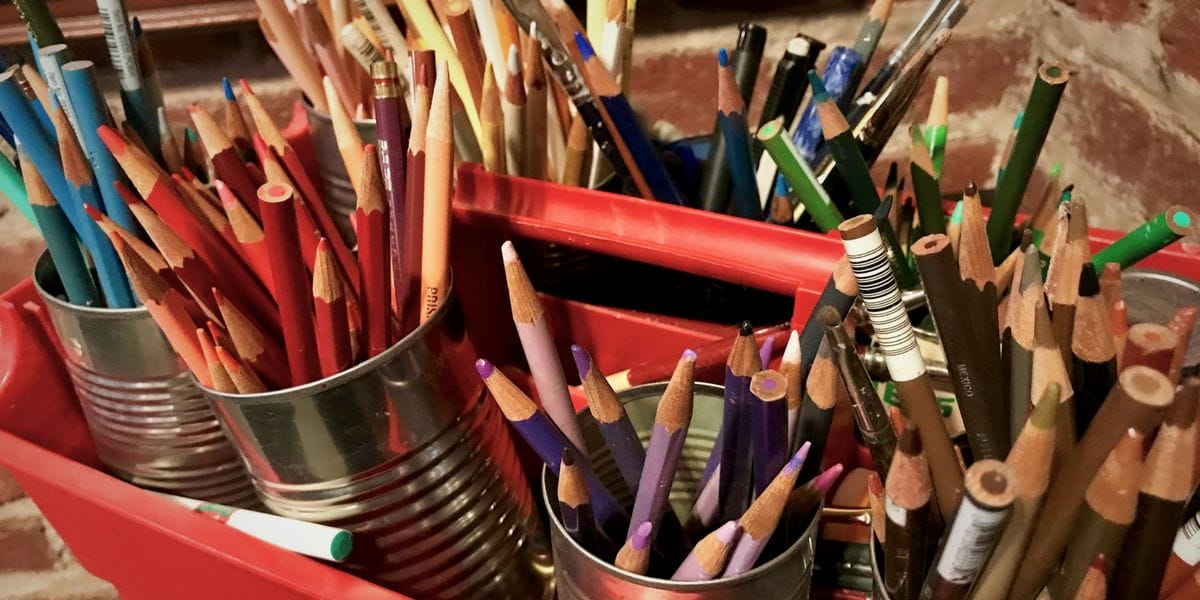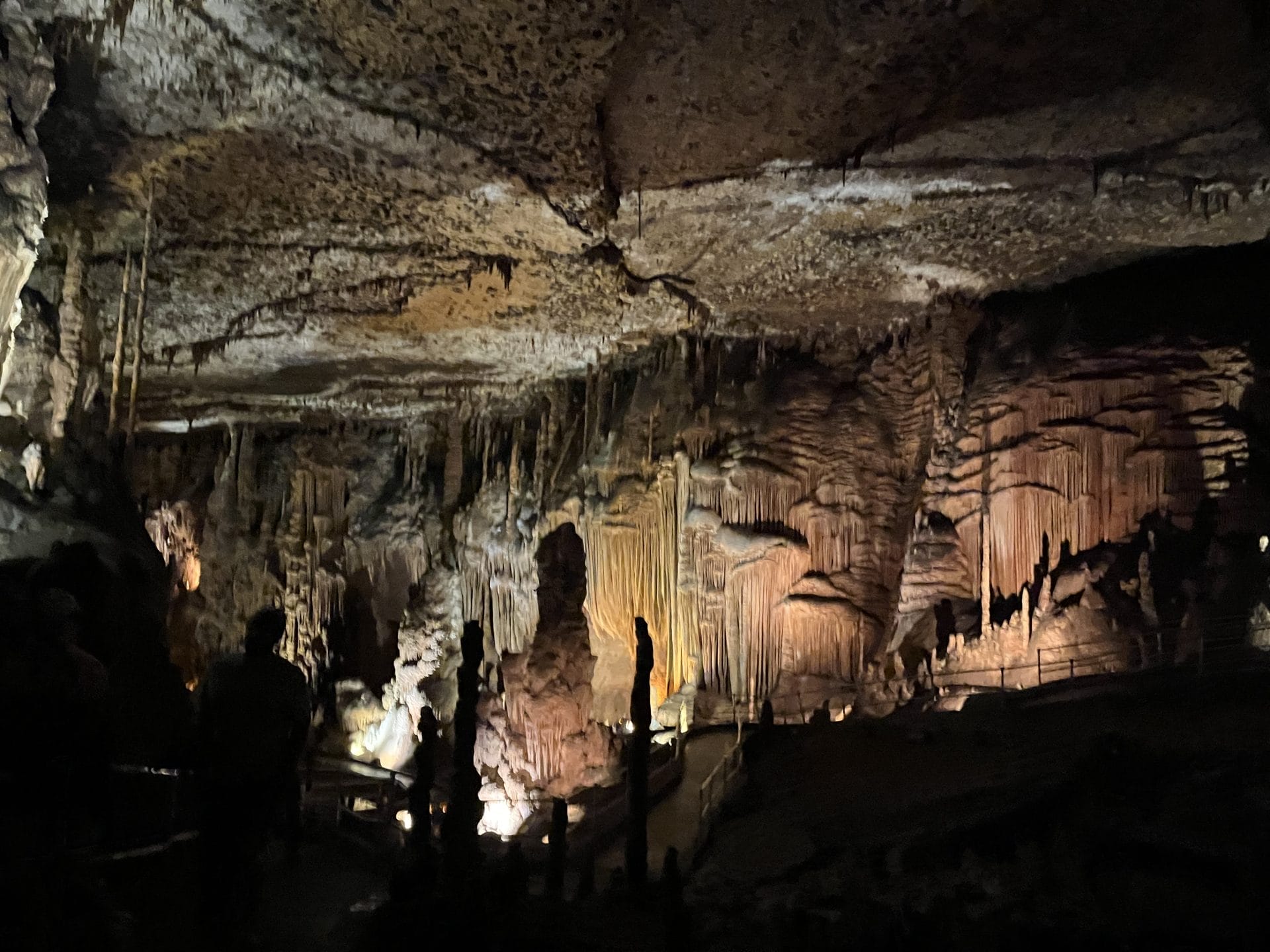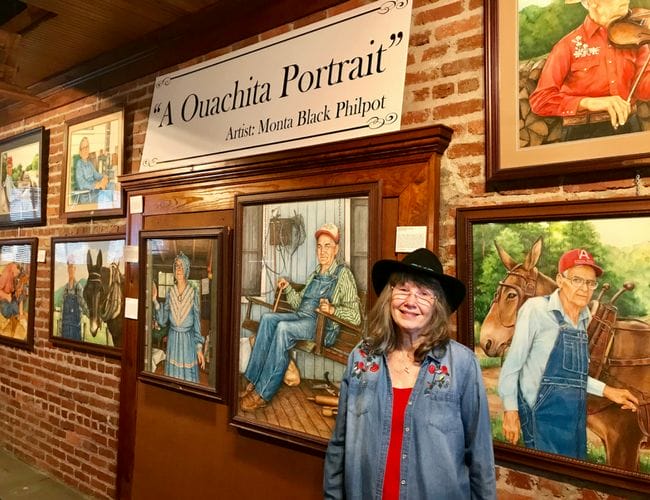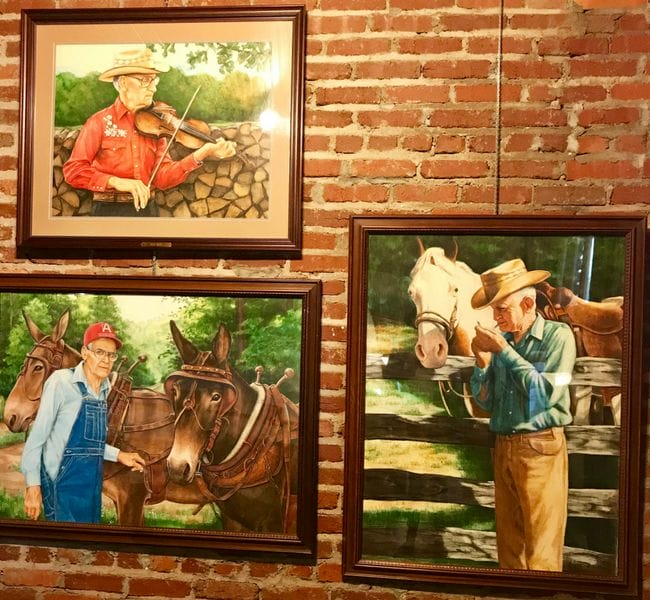

Uh oh...
It appears that you're using a severely outdated version of Safari on Windows. Many features won't work correctly, and functionality can't be guaranteed. Please try viewing this website in Edge, Mozilla, Chrome, or another modern browser. Sorry for any inconvenience this may have caused!
Read More about this safari issue.

I remember the first time I saw the collection. I had stepped into the Mena Train Depot for a bathroom stop and information about the Talimena Scenic Drive. My parents were visiting not long after I moved back to South Arkansas and I figured the drive would be a good way to spend a fall day in my new home turf. The Historic Mena Train Depot is manned by volunteers, and a man approached us as we entered. He asked us to sign the book registry, made small talk, and could tell I was intrigued by curiosities. So, I obliged when he asked if I wanted to see something spectacular. He walked me through a hallway full of local memorabilia and tourism brochures.
Beyond that hallway was another exhibit room. Here, he introduced us to “A Ouachita Portrait.” A Prismacolor pencil art collection completed by a local artist. I was hooked. He had pegged me from our first encounter in the front foyer and knew this was my kind of thing. Words like “only collection of its kind,” and “these people tell the story of this area” had me wanting to drink in more and get to know the folks who I was seeing displayed in front of me. The artist had captured them in their native environment, and the technique she used made me want to touch their face or place my hand on theirs. The glimmer in their eyes as they followed me around the room made me feel a kindred spirit in my heart beckoning me to pull up a chair.
In front of each piece, I found myself leaning in and stepping back. Leaning in and stepping back. Repeating this rowing motion over and over. I was intrigued by the detail and layers of color that formed each face. The wrinkles highlighted only by the age of their story. I wanted to know who these people were and why they were the chosen subjects.
The artist behind the collection is Monta Black Philpot, a former art instructor at Rich Mountain Community College and 5th generation Polk County resident. She is a portrait artist who lives in Mena. She grew up in south, way south Texas, but would spend her summers and holidays in Western Arkansas visiting her grandmother. While her usual medium is oil and acrylic paints, she became fascinated one day by the images she was getting by just playing with map pencils. She was at an art supply store looking for these pencils when someone mentioned these new tools called Prismacolor pencils. At the time there wasn’t much information about the pencils, the techniques to use to produce successful art, or what to do with them, but she picked them up anyway.
She had done a little work with charcoals and pastels and thought why not play a little with this new tool. That’s what artists and creatives like to do after all – “experience the freedom of pushing outside the box and experiencing something new.” After experimenting and playing she discovered that it was about more than just the pencils in her hand. The surface they were placed on made a difference as well. For her, it is a must that she uses a 100% rag illustration, cold press, heavyweight board; it proves to be the most forgiving.
Philpot has always been a portrait artist, so it just felt natural to choose a subject of a person to begin her diving in. And, that she did. No need to practice on small little papers or canvases, she picked up her normal size for a portrait and began her first piece in the collection – Mr. Mitchell “Rooster” Cogburn.
Mr. Cogburn is captured sitting on the swing on his front porch. Below him, you notice his iconic rolling pins and utensils. Taking up the craft and skill he learned from his father, Rooster, uses the native woods of his region of Arkansas to whittle away. When asked why he chooses this tool to create instead of others, since so many ladies are no longer cooking pies and doughs that need rolling out, he replied that they were really to be given as wedding presents to help the wife “keep her husband in line.” His wife Bessie is the hunter in their family, and the artist chose to include her in the story by keeping on the hooks above him one of the racks of deer horns hanging among their yard tools.
The collection itself tells the story of rural Arkansas and essentially, rural America. It is the story of a generation passing; people who formed and founded the cities in which we all now thrive. The pieces depict your grandma’s best friend, a woman who made quilts out of love, a married couple of deep conviction and strong faith, a young girl expressing the trade of her great-grandparents, a woman who got up at 4:00am to tend to her fields, a legend to rural electricity, a self-taught pianist, and a water witcher.
Rarely will you find an artist who does anything haphazardly. They may turn a “mess up” into a treasure, but the placement of their subjects, the environment that surrounds them, the shift in light, and the particular shade of each color are all pieces that tell a story. “A Ouachita Portrait” is no different. Philpot intentionally placed specific icons and treasures in each portrait to make sure the story of Arkansas was told alongside the lives of these individuals.
Take for instance A.J. Jordan or Delta Meador.
“Big Boy,” as he was known, was a South Arkansas icon. If you traveled Hwy 71 between Mena and Wickes, you were bound to know “the man on the side of the road.” He could turn seemingly junk into treasures, collectibles and souvenirs for those new or traveling through the area. He dons a new Arkansas Razorbacks cardinal red hat. And while his garments were probably worn and tattered, Philpot portrays him in his iconic railroad overalls. He looks like a combination of my Grandad and my Papa. I somehow trust him and want to crawl up in the empty metal chair beside him and watch the log trucks travel up and down the highway.
Ms. Delta Meador is the woman behind the quilt. The vibrant colors of the portrait draw you in, and you want to sit next to her on the couch and help her bind the quilt presently sitting on her lap. What she would probably share with you is the story of the family she is making this specific quilt for. They might be a family down on their luck, one with a new baby, or may have recently experienced physical loss of a home or furnishings. It’s just what she did to take care of people. Having lived through The Depression and raising 11 children (a set of triplets and two sets of twins) as a single parent, she didn’t have much to give away but her time and talents.
In years past, when the collection was initially compiled, it went on a bit of a tour. Of course, the collection found fame and notoriety locally and regionally, but it was also invited to visit the Rotunda of the Russell Senate Building in Washington D.C. While there, some of the second stories of the collection began to surface. From time to time, the artist was invited up to talk to groups traveling through the area or on field trips. On one such occasion, Mrs. Philpot was talking to a group of students from New Jersey. These children were from an urban, well-developed community. As she told them the stories of the subjects of her portraits, she asked if any of them had ever heard of things like whittling wood, truck farming, or water witching. The only piece they could personally connect with was the quilt. Some of them could remember their grandmother sewing and quilting.
It was in that moment that the bigger story of this collection began to unfold. While Philpot started out to capture the story of people who represented her childhood and the people of Western Arkansas that fascinated her, she began to realize she was capturing the history of America and American people through the stories of Arkansans in her own rural hometown. As the artist said, “these pieces represent a lifestyle that is vanishing.” A generation from now may never know the simple trades and skills of the Greatest Generation. Two generations removed may never know the experience of an “old hymn singing” or baptisms in the river. Being in a community without electricity and fighting for it by using your personal network will seem archaic and mundane. Using an old mule to plow, churning butter in a ceramic pot, handwriting letters and playing the fiddle may all be storied details of a curious past.
Her interest in them made these folks, who intentionally lived on “backroads out in the woods,” a set of local celebrities. When they would arrive at church people would mention seeing them in the PBS/AETN special that aired nationwide or seeing them in the magazines like Country Living, Southern Living, Southwest Art or AARP’s Modern Maturity. Philpot mentioned something that happened as she spent time with each of their subjects – her interest in them made them “vulnerable to share their story. They could trust me, and today that’s rare. Thankfully, they shared their life and skills with me.” The collection itself took nine years to complete as Philpot was still an art instructor and raising children at home.
Mentioned was the collection’s display in Washington D.C., but the collection also visited the Thomas Gilcrease Museum in Tulsa, OK. Here the collection took on a new dimension when they displayed it at the opening ceremony as living art. Those depicted in the portraits were invited to come and sit near their portrait. This type of display puts a certain pressure on both the subject and the artist. Did she depict them correctly? Can you recognize the features of their face, especially with them standing next to it? Did the portrait hide their flaws and bring out the heartwarming characteristics that made them the desired subject in the first place? And, with them standing there, honing their craft, does the drawing lift off the page and make you feel like you are standing next to its subject? Does the collection itself tell the story of the Ouachita mountain people living out a special, dare sacred, way of life?
“A Ouachita Portrait” may be Monta Black Philpot’s most widely known collection, but she has more recently completed a “Big Cats” series of oil paintings of larger cats like tigers that she has found at Turpentine Creek in Eureka Springs and the Little Rock Zoo. She is also known for her paintings of apples in both oil and colored pencil mediums. One thing Philpot does as she works on her pieces is work intently on making sure the details in her portraits are just so. Whether it’s the cover of a phone book barely in the picture, a vintage bottle of Campho Phenique, the lines of the added embroidery on a shirt, capturing the shades of a folded quilt, not over-emphasizing arthritic hands, the elements of a logo on a rusted Folgers can, or making sure the whole story of a person is captured in the background details that adorn their shelves and walls.
Standing among the collection the first time, I had the feeling I was surrounded by people I already knew. The artist exclaimed the same thing as we talked together in the gallery. I asked her what she felt when she was in the room with these drawings. Her response, “I feel like I’m at a family reunion. And the longer we stand here, the more comfortable I become as the stories and my time with them all begin to come back to me.”
“A Ouachita Portrait” is currently on display at the Historical Mena Train Depot along Arkansas State Highway 71 in Mena, Arkansas. Mrs. Philpot is beginning to shift her attention from realism and portraits to impressionist work. A trip later this year to New Mexico and Colorado will lead her new desire to capture the landscapes of the West. Her curiosities have her wondering what a collection could look like minus all the details of faces, hands, and hobbies. And instead, an ebb and flow of landscapes wrought with mountains, gardens, scenic byways, rocks, and trees. What could it be like to sit among something and just know its there?
Join the Conversation
Leave a Comment
2 responses to “Monta Black Philpot and “A Ouachita Portrait””
 Leave a Reply
Leave a Reply
We do the work.
You check your email.
Sign up for our weekly e-news.
Get stories sent straight to your inbox!
















 Leave a Reply
Leave a Reply
[…] a recent “pit stop” detour through the historic Mena Train Depot, I came across a gallery about the “Lum and Abner” show. I wondered if this was part of my […]
[…] near Dardanelle. When Mattie’s father is murdered, she travels to Ft. Smith to hire the infamous U.S. Marshal Rooster Cogburn. From there, the setting delves into Indian Territory as the pair, plus Texas Ranger LaBoeuf, track […]